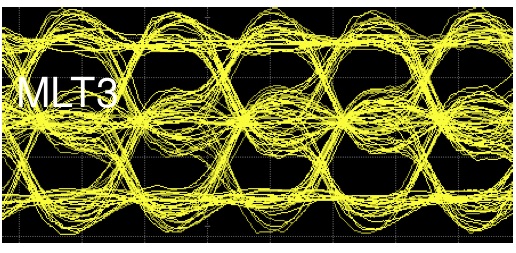MLT-3 Line Encoding
A 100 MHz data stream that uses a 4B/5B encoding therefore results in a125 MHz signal. However in Fast Ethernet, this 125 MHz signal is itself encoded as a mult-level signal using three signal levels (instead of the two levels used in Manchester encoding). The three signal levels are -1, 0, +1. This reduces the bandwidth required o the physcial cable to only 31.25 MHz, which is within the specification of the CAT5e cable used in UTP.

MLT-3 Encoding
The MLT-3 waveform can be viewed as an eye diagram, is an oscilloscope display in which a digital signal from a receiver is repetitively sampled and applied to the vertical input, while the data (clock) is used to trigger the horizontal sweep. The eye diagram is often used to assess the quality of physical signals in digital transmission, since it captures a summary of a long data stream, clearly showing whether the transitions between bauds are distinct. The opening at the centre of the eye can be used to diagnose problems, such as attenuation, noise, jitter, and dispersion that arise or characterize specific parts of the transmission system with one display.

Eye Diagram showing the 3 levels of an MLT-3 encoded waveform. The size of the Fast Ethernet line symbol in microseconds, i.e. one baud as 1/125 micro secs.
Example using MLT-3 encoding
Explain how the sequence of bits {0 0 0 1 1 1 0} are encoded using Multi-Level Threshold, MLT-3 encoding.
As in AMI, a 0 bit is encoded as no change of level.The line encoding using 3-level MLT encoding should be shown. The student should note the three levels used (+, -, 0) to reduce the required bandwidth to 31.25 MHz, suitable for transmission over the installed based of twisted pair cables.
1 is encoded as a level change, starting from zero, then moving to 1 for the first input +, then back to zero fro the next 1, down to - for the next 1 input and returning to 0 for the next 1 in the input data.
Encoded as: 000+0- - (assuming a zero start) , where 0 is no voltage, + is a positive voltage and - the negative voltage.
See also:
Gorry Fairhurst - Date: 01/11/2020

